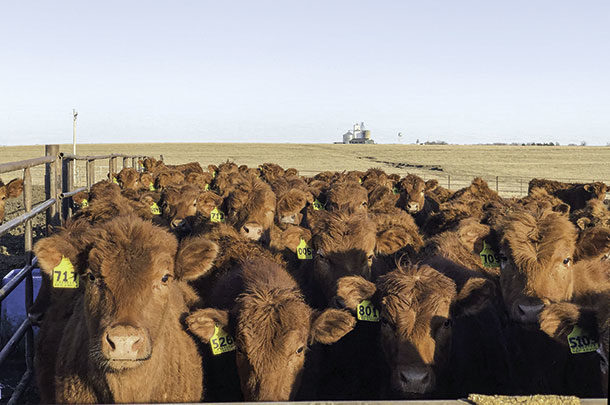It’s always critical for cow-calf producers to deliver weaned calves desirable to cattle buyers and feedlot operators. In these uncertain times of COVID-19, market pressures and shrinking bottom lines, it’s even more crucial to get it right. In today’s climate, cow-calf producers might be forced to count even more on their seedstock providers plus tap deeper into the mindset of the eventual buyer.
Purebred operations work hard to constantly align the focus on their own genetics. Progressive breeders often attempt to cover multiple bases with easy calving, high weaning and finishing weights, top-quality carcasses, longevity and docility, and other traits. It can be a tall task.
The seedstock producer’s vantage point
Jamie Courter, beef product manager at Neogen, believes seedstock producers have a responsibility to be knowledgeable about what is available and should make selection decisions based on the genomically enhanced expected progeny differences (EPDs) from their breed associations. “There is nothing more accurate to make decisions from. And if they’re running the 50K [generation genomic profiler], they will increase the accuracy of the EPDs in their bull sale catalogue to help commercial customers make better decisions.”
David Anderson, Texas A&M University AgriLife Extension livestock marketing economist, agrees and wonders if there could be an even more tangible connection between the two entities. If commercial owners worked with breeders to identify at minimum the parentage of their best animals, this could be beneficial. “There’s plenty of seedstock producers with shiny cattle that look good, but some really are better than others. We’ve got to drill down to the genetics. Dare to do things a little different. Really, it might be as simple as partnering on some tests to help the breeder identify lines they want to pursue.”
View of the commercial cattleman
Courter says many commercial operators look to their purebred providers as genetic consultants, because they often don’t have access to estimates of breeding value or genetic merit in their cattle, other than for the bulls they purchase. She believes when parentage and heritable trait testing is added, it provides additional feedback information, data and value. “When we understand the genetic potential in our females, we have the power to go back to the seedstock provider and say, ‘This is where I really need help. What bulls do you have that will match my need?’ Then we’re not overpaying for a bull we don’t need or missing out on one we do.”
Even modest gains in desired traits are impactful on a producer’s bottom line. “I tell people they’re already doing a good job of buying the bulls that match their breeding objectives. They sire 25 to 30 calves per year, but due to random biology, how do we know which heifers in the calf crop inherited the genes we want and paid our money for? It’s easier now when we can test them.”
Tom Brink, CEO of the Red Angus Association of America and founder of Top Dollar Angus, has covered multiple roles in the beef cattle industry and encourages commercial producers to think about ways to add value to their calf crop through getting involved in different genetically based programs. “More people understand if they upgrade the bull battery and really have a target on their genetics, they can get paid more. It used to be the value-added concept was about as much theory as reality. The question was – are we really capturing value? Today, we have advanced a long way from that.”
Anderson likens it to a balancing act and believes there are more opportunities for partnerships between the seedstock breeder and the commercial operator. “They have a calf to sell, but how do they improve it – squeeze more profits? It requires data and turning that data into information from which decisions can be made.”
Seeing is believing for the feedlot buyer
He also sees the potential for tightening connections once the calves leave the farm of origin. “There has been an informal partnership between commercial cattlemen and buyers for a long time. Buyers know whose cattle tend to do better than others, and those are the ones they pursue harder. So for ranchers maybe not seeing those return buyers, there are gains to be made, but once again, they might need help from their breeder and input from the feedlot buyer.”
Courter outlines numerous recently launched programs providing testing data by demonstrating value in genetically proven lots of cattle, but warns it will take time to reach the feedlot sector in greater degrees.
“I think the next trickle-down needs to be the wider use of this information in the feedlot. Whether it’s that pull through demand on the genetically superior cattle we’re starting to see or just the ability to take individual information on an animal to assist in grouping more uniform lots of cattle.”
Brink agrees and sees buyers in combination with packing houses becoming more involved. “It’s not necessarily something that has been there forever. Major packer buyers now tell me they care about genetics more than ever. It’s a different response than you would have got years ago when they said, ‘We just kill cattle, we’re not trying to shape the future with better genetics.’”
He says the alignment effort is becoming serious and points to several smaller groups as examples. “Many are pretty fully integrated, maybe not by ownership, but a structured supply chain from genetics to packer – and on a bigger scale that hasn’t been there before.”
For the commercial cattleman seemingly caught in the middle, with perceived and real pressures from different segments of the supply chain, and the strain on cattle markets due to the unprecedented pandemic, it can be an anxiety-filled time.
Brink urges producers to stay positive. “We are in interesting and challenging times. I’ve been involved in this business now 35 years, and I’ve never seen more real work being done and energy put towards different forms of this alignment. It won’t all come to fruit, no doubt. But some will, and it is going to change the business. It’s already changing it.”












